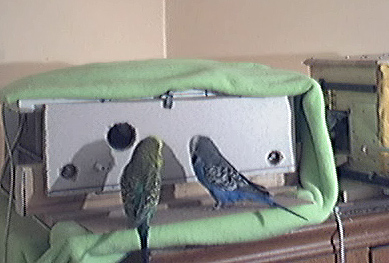TOP COCK
Complex social creatures such as budgies are particular about choosing a mate especially the hens. She is dependant on her mate to provide her with food as she incubates the eggs and rears the chicks. Keeping an eye on the aviary enables the keeper to manage the aviary before things get out of control. Any bullying or fights must be dealt with - guide lines can be found HERE. With a bit of shuffling and perseverance most birds will settle with a pal or mate. Bringing in new birds always perks up a stagnant aviary.
This clip was taken in 2005 and is typical of a flock of budgies when nests are made available to them. Two mature hens want to breed and there are three nests open. However it’s rare for the hens to pair up nicely with different cocks and start nesting without any problems. This is particularly the case when the numbers are low.
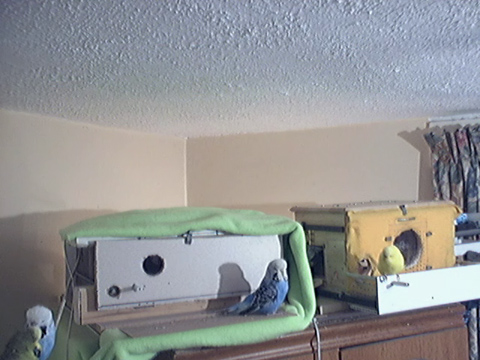
CHRISTMAS 2005
The scene depicts two home-made nests on a wardrobe in a bedroom aviary with ten budgies - six cocks and four hens. Eight of the budgies are from pet-shops and two from a breeder: All are past sexual maturity apart from two - the yellow hen and a grey cock. Two of the budgies are strongly bonded - “Blue” (hen) and “Dg” (cock).
TOP COCK
INTRODUCTION:
"Splash-dash" , a highly intelligent bisexual cock is on the line with his current boyfriend "Lg" (Light-Green). He never had a female mate and associated a lot more with the cocks. “Lg” is a clever bird. He knows his own mind and is more flirtatious. The budgie on the platform is "Queenie-hen" who came with “Splash-dash“. She was a very dominant hen with a strong personality. She's jealous of "Blue" who's paired up with "Dg", (They're out of shot, probably in the tree). She’s low ranking, very popular but a little neurotic. He's the lowest ranking of the flock and a bit gormless: "Blue" sticks up for him a lot. He's heterosexual although he was intimately close to “Lg“ when I got them but I believe it was one sided. The pair want to start nesting in the BRICK-WOOD NEST on the left but “Queenie-hen” is making life very difficult for them. "Yen" the yellow hen is a youngster who is easy going and playful but sometimes mischievous.
DESCRIPTION:
"Lg" flies to the platform to vie for “Queenie-hen” (or maybe for a nest for his boyfriend) but she rejects him. He flies to “Yen” hoping for better luck but she chases him away - they were very close at one point but she’d grown off him. “Queenie-hen” is hoping "Dg" will join her but he's strongly bonded to “Blue” and stays with her. She flies to the other nest which isn't taken and checks it for security - with her own nest she'll have a better chance of persuading him. Meanwhile “Blue” returns to her nest with her mate seeing that the “coast is clear“. Immediately “Queenie-hen” interrupts them and “Blue” who is lower ranking flies off. The grey cock joins them. He's a tough and smart heterosexual and is beginning to become interested in the hens. "Dg" feels uneasy and flies back to “Blue“. They returns shortly afterwards to continue with their plans but "Lg" flies to the nest and tries to split them up. This may have more to do with him losing a boyfriend than vying for “Blue”. But as soon as “Blue” clears him off, “Queenie-hen” returns. “Blue” doesn't allow herself to be intimidated this time and forces her on to the other nest. “Queenie-hen” doesn't give up that easily and takes her chance as “Blue” climbs down the line to check for other ways in, to occupy the nest. "Lg" follows and chases “Dg” away. He may be hoping she'll change her mind but she's resolute over her choice of mate. He joins his old boyfriend on the BREAD-BIN NEST only to be cleared off again by her and she checks the nest out again. "Dg" stays at the nest - he may have been considering giving up on “Blue” but the grey cock shows an interest and flies down on to the front panel. "Dg" gets nervous and flies back to “Blue“. This was a stalemate situation which was only broken after five birds were moved into different zones.
CHECK-POINTS:
Soon after “Blue” returns to the line, “Queenie-hen” sees her. Although a dominant bird she gets unnerved and flies off.
When “Lg” joins them on the platform he threatens “Dg” but he stands his ground. But rather than confronting him himself he indicates to “Blue” to clear him off either by nudging her or vocally.
Note how “Dg” performs slight synchronised head movements towards “Blue” as she examines the entrance. He’s actively encouraging her to go in and is buoyed up. This is common behaviour as most hens won’t mate without a nest.
“Dg” scratches and fluffs out when “Blue” climbs down the line. This is normally a sign of relief at the end of a tense situation. The reason for this is not clear. “Blue” may have indicated that “Queenie-hen” had given up.
“Dg” was considering defending the nest before “Queenie-hen” occupied it. He made a slight lurch towards her before she entered it but quickly changed his mind. She then hinted in the same fashion what the outcome would be.
INTERPRETATION:
“Queenie-hen” was never very popular with the cocks possibly due to her aggressiveness - “Blue” was always the favourite. She was determined to take "Dg" from “Blue” although there were 4 unpaired adult cocks in the aviary at the time although one was flightless: The grey cock was just four months old. Even with "Dg" out of the way for a time the hens wouldn't go with them. The most likely reason was that they considered them unsuitable to support them and their chicks when they arrived. “Queenie-hen” was aggressive by nature but not a bully. The only way she could achieve her goal was to try to split them up which she nearly succeeded in doing - note how "Dg" stays at the BREAD-BIN nest for a while as she checked it out.
EPILOGUE:
“Blue” laid eggs by “Dg” in both nests and in the middle triple BRICK-WOOD NEST in the COMPOUND but none hatched.
“Queenie-hen” finally got “her man” later in the following year when “Blue” was separated from “Dg”. She laid eggs in the BRICK-WOOD NEST on the wardrobe and the pair appeared to be bonded. Three of the eggs were later found to be destroyed with one addled. She had become unsettled for no apparent reason and was searching for another nest. Later the pair were put in the NEW HOSPITAL after they recovered from a fungal infection. She laid eggs in the right-hand nest but none hatched.
After the forecourt to the old hospital was completed I brought the grey cock and “Yen” up from the downstairs pen and put them in it but they didn’t pair up. However when they were released into the aviary later on they did. She laid eggs in the BRICK-WOOD NEST on the wardrobe but didn‘t incubate them. The reason behind this is not entirely clear. Although they were affectionate together and an egg had been fertilized they didn‘t seem bonded. It appeared to be a charade to escape an unwanted mate. I got them both together and they were from the same breeder so they may have been related. I paired her with another cock (“Tq”) again in the old hospital. He was an unsophisticated bird with low intelligence and they didn‘t bond. He however was very fond of “Splash dash” and they were together a lot. She died in mysterious circumstances when I found her behind the TRIPLE BRICK-WOOD NESTS with no sign of injury or illness and no serious social problems in the colony at the time.
"Lg" was trying to court a timid hen I got from a cage breeder at the time -“Lgh”. He became besotted with her and followed her around a lot. They spent a lot of time in the OLD HOSPITAL and she may have been using it as a refuge. She showed no sign of sickness although she was often under the lamp as if cold. She didn't want to mate and I believe the pair committed suicide by not taking grit.
“Dg”. Lived to an old age and spent his last days in the GROUND LEVEL HOSPITAL
“Blue” checks out THE BREAD-BIN NURSERY
(Earlier in the day)
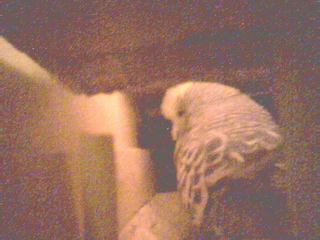
A week later
NO HASSLE
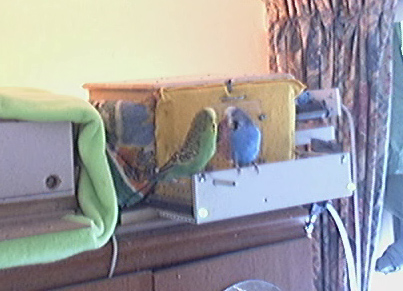
A YEAR LATER
“Queenie-hen” nests with “Dg”
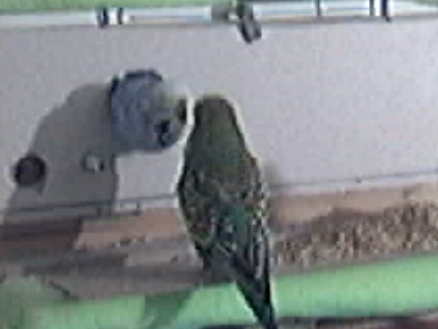
“Yen” and the grey cock - segregated
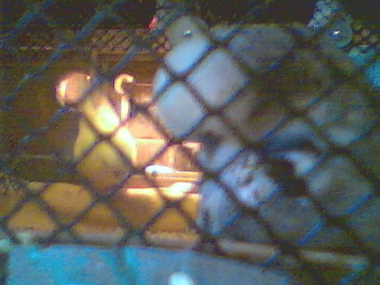
“Splash-dash” and “Tq” in the forecourt of the RIGHT HAND DOUBLE
BRICK-WOOD NEST
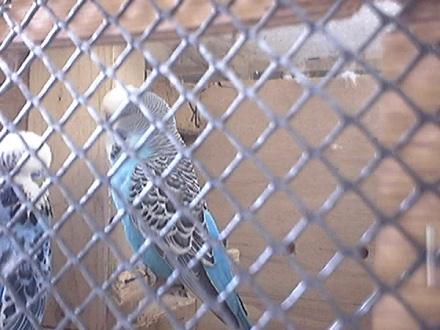
“Queenie-hen” takes her chance in THE NEW HOSPITAL
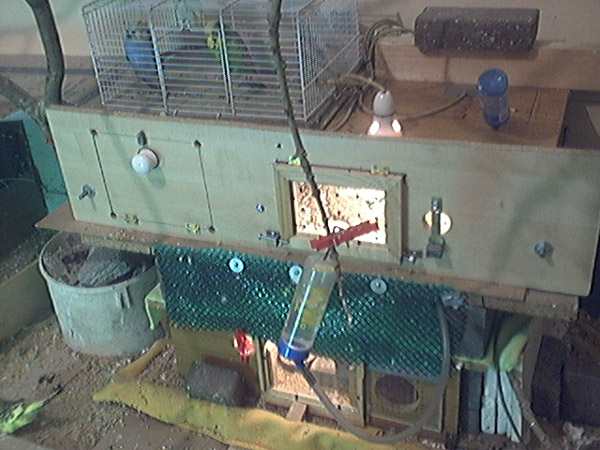
“Queenie-hen” pays a visit
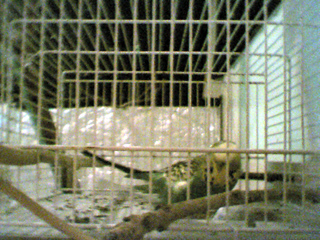
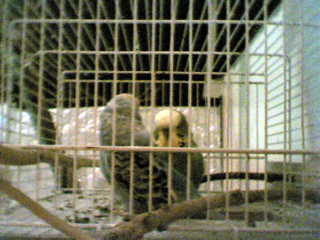
“Yen” paired up later - charade?
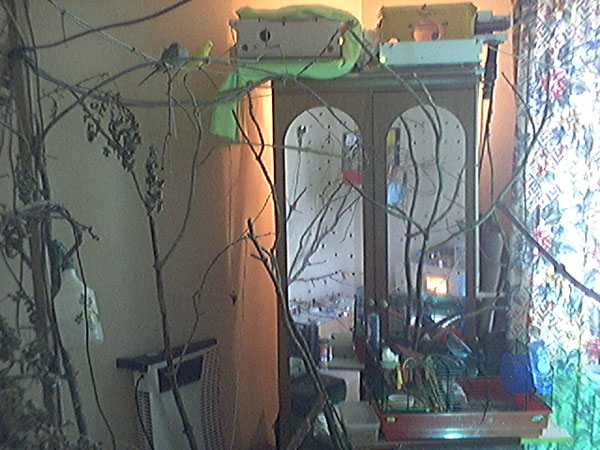
The Grey cock waits
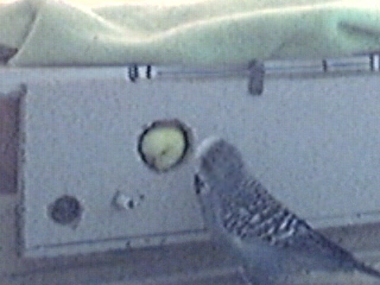
“Tq” in the old HOSPITAL FORECOURT - rejected
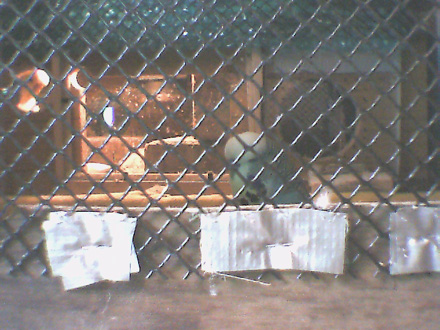
“Lg” with soul-mate “Lgh” in the OLD HOSPITAL two months earlier
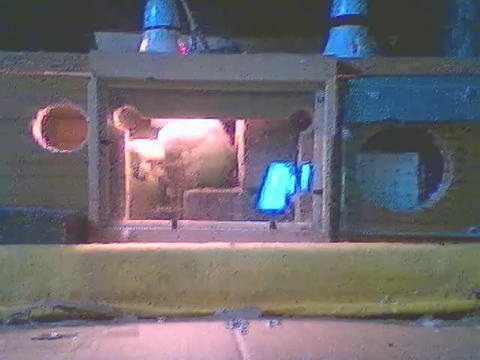
CONCLUSION:
In a situation like this where a bonded pair are low ranking it’s better to provide them with separate breeding facilities at the outset.
………………………………................................................................................................................................................................................................................
NOTES:
“Lg” was at least three months old when I got him and he appeared to be a hen. His cere was the typical buff colour with a thin blue ring at the nostrils. Over the weeks the rings slowly increased in size to eventually display the normal cere of a cock.
THE CERE of “Lg” (Three days after acquisition)
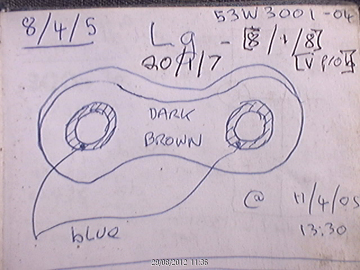
Queenie-hens’ cere was also odd. One would expect her to have the normal buff colour turning to dark brown on ovulation. Instead a small ring around the nostrils was pale with a large light blue area (marked LU). The perimeter was again pale.
THE CERE of QUEENIE HEN
(6 months old)
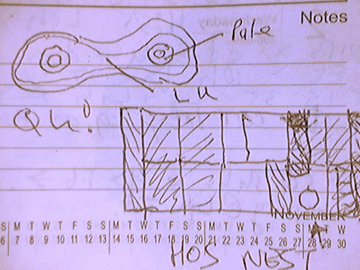
“Blue” took to “Dg” instantly and subsequently never showed interest in other cocks when he was available.
“Dg” rebuffed advances by “Yen” a month after acquisition.
Over a period of nine years I acquired three outstanding cock budgies which were so superior from the point of view of the majority of the hens that the others were put at a considerable disadvantage. Two were from a pet shop and the other from a garden aviary. Two of the cocks were of the natural deep green colour that one sees in their native habitat in Australia. A single offspring of one also had the same plumage and was also very popular.
Two yellow “spangle” cocks were later acquired on separate occasions from pet shops. Both these birds had serious psychological problems and found difficulty in forming bonds with either sex. Two other budgies with similar colours suffered badly with relationships. These associations may just be a statistical quirk.
“Dg”s prowess with the hens was only surpassed two years later when I introduced another pet shop budgie which I called “T2”. He was the third outstanding cock and had light blue plumage and was appealing to the hens as “Dg” was who had gone back to “Blue“. He paired up with another pet shop hen that I acquired the following year and produced two chicks in the Brick-wood nest on the wardrobe. The second and last pet-shop budgies that bred in the aviary arrived later in the year. They came in a group of six and were plain yellow and reared a single chick in the same nest.
TOP COCK
